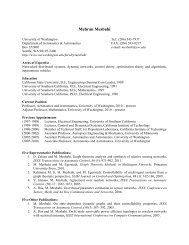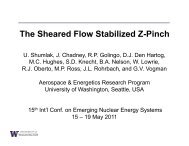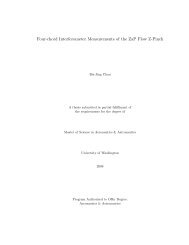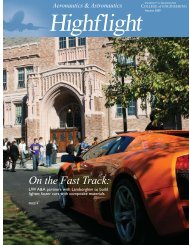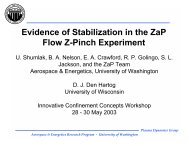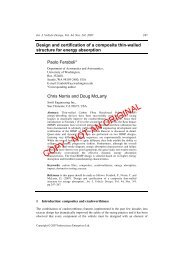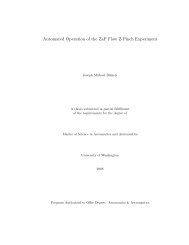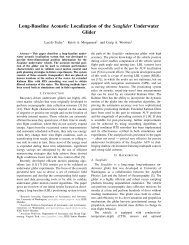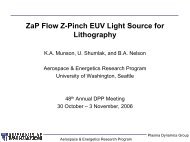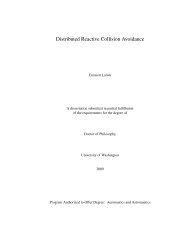Controllability and Trajectory Tracking for Classes of Cascade-Form ...
Controllability and Trajectory Tracking for Classes of Cascade-Form ...
Controllability and Trajectory Tracking for Classes of Cascade-Form ...
Create successful ePaper yourself
Turn your PDF publications into a flip-book with our unique Google optimized e-Paper software.
Proceedings <strong>of</strong> the 2001 IEEE Conference on Decision <strong>and</strong> Control, pp. 3031-3036<strong>Controllability</strong> <strong>and</strong> <strong>Trajectory</strong> <strong>Tracking</strong> <strong>for</strong> <strong>Classes</strong> <strong>of</strong><strong>Cascade</strong>-<strong>Form</strong> Second Order Nonholonomic SystemsKristi A. Morgansen †Control <strong>and</strong> Dynamical SystemsCali<strong>for</strong>nia Institute <strong>of</strong> TechnologyMC 107-81Pasadena, CA 91101kristi@cds.caltech.eduAbstractIn this work we discuss classes <strong>of</strong> nonlinear systemswith drift that can be reduced to the cascade <strong>of</strong> a linearsystem <strong>and</strong> a drift-free nonholonomic system. Buildingon previous work with amplitude-modulated sinusoids<strong>for</strong> trajectory tracking in drift-free systems, wepresent algorithms <strong>for</strong> configuration trajectory trackingin these dynamic settings. Results are demonstrated insimulation <strong>for</strong> representative examples.1 IntroductionWhile all mechanical systems are inherently dynamic,in certain circumstances designing a system controllerusing a kinematic model will produce acceptable per<strong>for</strong>mancefrom the system. For example, at low speeds,inertial effects might be small enough to neglect. In actuality,however, many <strong>of</strong> the physical systems that wewould like to study will not per<strong>for</strong>m well if we neglectdynamics. Additionally, a number <strong>of</strong> systems <strong>of</strong> interestsuch as wheeled vehicles, manipulators with passivejoints, spacecraft, <strong>and</strong> underwater vehicles are eitherdesigned with fewer actuators than degrees <strong>of</strong> freedomor must be able to function in the presence <strong>of</strong> failedactuators.The state equations <strong>for</strong> underactuated mechanical systemsevolve under a number <strong>of</strong> first-order (kinematic)<strong>and</strong> second-order (acceleration) nonholonomic constraints.When the constraints on a mechanical systemare purely kinematic, one can reduce ([8, 14]) thesecond-order equations to the cascade <strong>of</strong> a set <strong>of</strong> integratorswith a drift-free nonholonomic system <strong>of</strong> the<strong>for</strong>mm∑ẋ = g i (x)u i , x ∈ R n , u ∈ R m . (1)i=1In such cases, control <strong>of</strong> the overall system reduces to† This work was supported in part by the US Army ResearchOffice under grants DAAG-55-97-1-0114 (Center <strong>for</strong> Dynamics<strong>and</strong> Control <strong>of</strong> Smart Structures) <strong>and</strong> DAAL-03-92-G-0115 (Center<strong>for</strong> Intelligent Control Systems), by Brown University undergrant DAAH-04-96-1-0445 <strong>and</strong> by the National Science Foundationthrough an Engineering Research Center grant <strong>and</strong> throughNSF grant CMS-9502224.control <strong>of</strong> the underlying drift-free nonholonomic system.As is well known, the linearization <strong>of</strong> a nonholonomicsystem about any point will be uncontrollable,<strong>and</strong> such systems cannot be stabilized to a point withsmooth state feedback [4]. However, nonlinear controlmethods have been developed <strong>for</strong> many such drift-freesystems in order to accomplish tasks such as motionplanning <strong>and</strong> stabilization. Among these approachesare discontinuous time-varying control [10, 11], timevarying<strong>and</strong> averaging methods [18, 16, 17] <strong>and</strong> hybridcontrol [3, 21].The task <strong>of</strong> control in the context <strong>of</strong> second-order systemsis simplified if one can be satisfied with studyingthe behavior <strong>of</strong> the configuration states <strong>of</strong> a systemrather than both configurations <strong>and</strong> velocities. Inthis configuration context, the concept <strong>of</strong> configurationcontrollability has been studied in [15] <strong>and</strong> trajectorytracking from motion primitives with oscillatory controlshas been considered in [13, 6]. Although our interestin this work focuses on the task <strong>of</strong> trajectorytracking, the study <strong>of</strong> averaging <strong>and</strong> oscillatory controls<strong>for</strong> the task <strong>of</strong> stabilization is closely related <strong>and</strong>references to this topic can be found in [6]. Additionalwork involving dynamical nonholonomic systems canbe found in [2, 3, 7, 19] <strong>and</strong> the references therein.In this work we study classes <strong>of</strong> nonlinear systems withdrift obtained from the cascade <strong>of</strong> a nonholonomic integrator<strong>and</strong> a linear time-invariant system. Specifically,we address the idea <strong>of</strong> extending open-loop trajectorytracking controls derived from amplitude-modulated sinusoidsto these classes <strong>of</strong> second-order nonholonomicsystems. We will show that we can achieve configurationtracking in the dynamic setting with such anextension. This result is known in the case when thecontrols <strong>of</strong> a nonholonomic system are passed througha set <strong>of</strong> integrators. For the general case however, theseresults have not previously been developed. In Section2, we discuss the classes <strong>of</strong> second-order systems wewill study <strong>and</strong> present relevant examples. Accessibility<strong>and</strong> controllability are shown in Section 3. Our mainresults are given in Section 4 where we show how to
construct configuration tracking controls <strong>for</strong> our classes<strong>of</strong> second-order systems. In Section 5, we discuss ourresults <strong>and</strong> some directions <strong>for</strong> continued research.Recall that the equations describing an underactuatedmechanical system can be written asM(x)ẍ + C(x, ẋ) + P (x) = B(x)u, (2)where x ∈ R n , u ∈ R m , B(x) = [ ˜B T (x), 0 T ] T <strong>and</strong>˜B(x) ∈ R m×m . One may solve these equations <strong>for</strong> ẍ<strong>and</strong> use feedback to getẍ =m∑g i (x)u i + h(x, ẋ) = G(x)u + h(x, ẋ).i=1In addition to these mechanical systems, one has twoadditional more or less natural classes <strong>of</strong> systems obtainedby cascading a drift-free nonholonomic system(1) with a set <strong>of</strong> integrators. These three classes canbe summarized as{ ˙ξ = u(CI)ẋ = ∑ mi=1 g i(x)ξ i{ ∑ m ˙ξ =(CS)i=1 g i(ξ)u iẋ = ξ(CM){ ˙ξ =∑ mi=1 g i(x)u i + h(x, ξ)ẋ = ξrespectively termed cascade input (CI), cascade state(CS), <strong>and</strong> cascade mechanical (CM). We could generalizefurther by replacing the set <strong>of</strong> integrators witha full linear system, but will leave this setting <strong>for</strong> anappropriate lengthier discussion. In the following workwe will focus on the subclass <strong>of</strong> (CM) systems whereh(x, ẋ) = 0. In general this disallows the presence <strong>of</strong>Coriolis, centrifugal <strong>and</strong> gravity <strong>for</strong>ces as well as damping<strong>and</strong> Coulomb friction. However, in some circumstancessuch as systems with a triangular structure, thisassumption can be met after the elimination <strong>of</strong> termsvia feedback <strong>and</strong>/or state space trans<strong>for</strong>mations.As an example, by extending the nonholonomic integratorẋ 1 = u 1 , ẋ 2 = u 2 , ẋ 3 = x 1 u 2 − x 2 u 1 to (CI)-(CM),we have(nhi − ci)(nhi − cs)(nhi − cm)X X 2 2X 1nonholonomic integrator ż⎧1 = v 1 , ż 2 = v 2 , ż 3 =⎨ ẍ 1 = u 1z 1 v 2 − z 2 v 1 . Thus we can design controls <strong>for</strong> the nonholonomicintegrator <strong>and</strong> apply them to the kinematicẍ 2 = u 2⎩ẋ 3 = x 1 ẋ 2 − x 2 ẋ 1mobile robot. We will use this example to demonstrateconfiguration tracking with (CM) systems.⎧⎨ ẍ 1 = u 13 <strong>Controllability</strong>ẍ 2 = u 2⎩ẍ 3 = ẋ 1 u 2 − ẋ 2 u 1The systems we are considering here fall into the class⎧<strong>of</strong> control affine nonlinear systems with drift:⎨ ẍ 1 = u 1m∑ẍ 2 = u 2⎩ẋ = f(x) + g i (x)u i (6)ẍ 3 = x 1 u 2 − x 2 u 1An important point to note in the mechanical extension<strong>of</strong> the nonholonomic integrator is that the third stateis integrable. Namely x 1 u 2 − x 2 u 1 = d dt (x 1ẋ 2 − x 2 ẋ 1 ).2 ModelsThis system then reduces to the <strong>for</strong>m (CI) <strong>and</strong> is effectivelykinematic. Conditions <strong>for</strong> the equivalence <strong>of</strong>a given mechanical system to a kinematic structure arediscussed in [14] <strong>and</strong> feedback trans<strong>for</strong>mations to convertmechanical systems to (CI) <strong>for</strong>m are shown in [8].To demonstrate a controllable (CM) system, considerthe vehicle in Fig. 1a with unit axle length <strong>and</strong> wheelradius. A kinematic description <strong>of</strong> the position <strong>and</strong>F x 1Fx2X 1(a)(b)Figure 1: Differential drive two wheel vehicle (a), <strong>and</strong>underactuated planar link (b).orientation <strong>of</strong> the axle center is given byẋ 1 = cos(θ)u 1 , ẋ 2 = sin(θ)u 1 , ˙θ = u2 . (3)Now consider the equations <strong>of</strong> motion <strong>for</strong> the center <strong>of</strong>mass <strong>of</strong> an underactuated link in the plane (Fig. 1b).Arbitrary <strong>for</strong>ces can be applied to a free joint at oneend <strong>of</strong> the link, but no torques may be applied. Onecan show (e.g. [1]) that the equations <strong>of</strong> motion <strong>for</strong> thissystem can be reduced toẍ 1 = cos(θ)u 1 , ẍ 2 = sin(θ)u 1 , ¨θ = u2which is a mechanical extension <strong>of</strong> (3). With the statespace trans<strong>for</strong>mationz 1 = x 1 cos(θ) + x 2 sin(θ)z 2 = θ (4)z 3 = 2(x 1 sin(θ) − x 2 cos(θ)) − θ(x 1 cos(θ) + x 2 sin(θ))<strong>and</strong> the control space trans<strong>for</strong>mationv 1 = r 1 u 1 − r 2 u 2 (x 1 sin(θ) − x 2 cos(θ))v 2 = r 2 u 2 (5)the system equations (3) can be converted into thei=1
where x ∈ M, M is a smooth n-dimensional manifold<strong>and</strong> u ∈ R m . For a complete treatment <strong>of</strong> nonlinearaccessibility <strong>and</strong> controllability, the reader is referredto [12, 22]. We will state the relevant definitions here<strong>for</strong> reference.Definition 3.1 The system (6) is controllable if <strong>for</strong>any two equilibrium points p, q ∈ M, there exists a finitetime T <strong>and</strong> control functions u : [0, T ] → R m suchthat x(0) = p <strong>and</strong> x(T ) = q. The system (6) is smalltime locally controllable (STLC) if <strong>for</strong> every <strong>for</strong> equilibriumpoint p ∈ M <strong>and</strong> T > 0, the set reachable fromp in time T contains p in its interior.From [23], we have the following result <strong>for</strong> (CI) systems.Proposition 3.2 (Sussmann [23]) Given any driftfreecontrollable nonlinear system (1), the cascade inputsystem (CI) is both controllable <strong>and</strong> STLC.<strong>Controllability</strong> results <strong>for</strong> (CS) <strong>and</strong> (CM) systems arenot as strong as <strong>for</strong> (CI) systems, however, each <strong>of</strong> theseclasses is fully accessible. Under certain conditions,STLC can also be shown.Proposition 3.3 Given any drift-free controllablenonlinear system (1), the cascade state system (CS)is fully accessible.Pro<strong>of</strong>: In order <strong>for</strong> a nonlinear system to be accessible,we simply need to show that the Lie Algebra RankCondition (LARC) is satisfied at all p ∈ M. Definez = [ξ T , x T ] T , <strong>and</strong> rewrite the overall system equationsin the <strong>for</strong>m[ ]0ż = + ∑ [ ]gi (ξ)uξ0 i = ˜f(z) + ∑ ˜g i (z)u i .iiStraight<strong>for</strong>ward calculations show that[ ][gj (ξ), g[˜g j , ˜g i ] =i (ξ)]0[ ][gk (ξ), [g[˜g k , [˜g j , ˜g i ]] =j (ξ), g i (ξ)]]0.[˜f, ˜gi][˜f, [˜gj , ˜g i ]]==.[[0g i (ξ)]0[g j (ξ), g i (ξ)]As long as the original drift-free system is controllable,these vector fields will span R n × R n at all points. ✷]Proposition 3.4 Any cascade state system (CS) fullyaccessible with Lie brackets <strong>of</strong> order no more than fouris STLC.Pro<strong>of</strong>: For i = 1, . . . , m let δ i be the number <strong>of</strong> occurrences<strong>of</strong> the vector fields g i <strong>and</strong> δ 0 be the number<strong>of</strong> occurrences <strong>of</strong> the vector field f in a Lie bracket B.From [22], we refer to a bracket B as bad if δ 0 is odd <strong>and</strong>each δ i is even <strong>and</strong> good otherwise. A sufficient condition<strong>for</strong> a system to be STLC is that all bad brackets atan equilibrium point p are linear combinations <strong>of</strong> goodbrackets <strong>of</strong> lower degree. From the previous proposition,we see immediately that the only bad brackets<strong>of</strong> degree less than four are those <strong>of</strong> degree three withi = j <strong>and</strong> δ 0 = 1 or 3. However, in those cases the badbrackets are identically zero ([g i , g i ] ≡ 0 <strong>and</strong> f(p) ≡ 0).✷Proposition 3.5 (Reyhanoglu et al. [20]) A cascademechanical system (CM) is fully accessible if eachnonlinear state equation is nonintegrable.Proposition 3.6 (Reyhanoglu et al. [20]) If a(CM) system is fully accessible with the brackets{g i , [f, g i ], [g j , [f, g i ]], [f, [g j , [f, g i ]]]}, then it is STLCfrom all equilibrium points.While we do not have a general controllability statement<strong>for</strong> (CS) <strong>and</strong> (CM) systems, we will see in the nextsection that when the drift-free portion <strong>of</strong> the systemis controllable, we can always per<strong>for</strong>m configurationtracking.4 <strong>Trajectory</strong> <strong>Tracking</strong>As shown in [5, 16, 17, 18], amplitude-modulated sinusoidalcontrols can be used to generate motion inthe constrained states <strong>of</strong> a drift-free nonholonomic system.We refer the reader to the references <strong>for</strong> details<strong>and</strong> state the basic result here. For readability, we willsometimes suppress explicit time dependence.Proposition 4.1 Given the twice differentiable functionsx d (t) ∈ R n <strong>and</strong> a controllable, drift-free nonholonomicsystem (1), there exist ω-parameterized controls<strong>of</strong> the <strong>for</strong>m2(n−m)∑u (ω)i (t) = γ i (x d , ẋ d ) + α ij (x d , ẋ d ) sin(λ ij ωt)2(n−m)∑+j=1j=1β ij (x d , ẋ d ) cos(µ ij ωt) (7)such that, <strong>for</strong> matched initial conditions <strong>and</strong> with respectto an L 2 norm, lim ω→∞ x (ω) (t) = x d (t).
Note that <strong>for</strong> each state x i such that ẋ i = u i , we willhave γ i = ẋ d,i .Example: Consider the nonholonomic integrator ẋ 1 =u 1 , ẋ 2 = u 2 , ẋ 3 = x 1 u 2 − x 2 u 1 <strong>and</strong> the controlsu 1 (t) = ẋ d,1 + √ ω sin(ωt)u 2 (t) = ẋ d,2 − √ ωβ(t) cos(ωt) (8)where β(t) = ẋ d,3 −x d,1 ẋ d,2 +x d,2 ẋ d,1 . Integrating each<strong>of</strong> the controls once by parts <strong>and</strong> assuming matchedinitial conditions leads tox 1 (t) = x d,1 (t) − 1 √ ωcos(ωt)x 2 (t) = x d,2 (t) − 1 √ ωβ(t) sin(ωt)−√ 1 ∫ td(β(τ)) sin(ωτ)dτ.ω dτThe third state then evolves according to( )1x 3 (t) = x d,3 (t) − √ω ẋ d,1 + sin(ωt) ·0∫ t0d(β(τ)) sin(ωτ)dτdτTo eliminate the integral terms, we use a version <strong>of</strong> theRiemann-Lebesgue lemma:Lemma 4.2 (Riemann-Lebesgue [9]) Let f be <strong>of</strong>bounded variation on [a, b] <strong>and</strong> let φ ∈ [0, 2π]. Thenlim ω→∞∫ ba f(t) cos(ωt + φ)dt = o ( 1ω).In the limit as ω becomes large, we have x (ω) (t) ≈x d (t).Now we will show how a result <strong>of</strong> this <strong>for</strong>m <strong>for</strong> a driftfreesystem can be extended to our classes <strong>of</strong> secondordersystems to produce configuration tracking.Corollary 4.3 ((CI) Configuration <strong>Tracking</strong>)Given a controllable (CI) system, three times differentiablefunctions x d (t) <strong>and</strong> approximate trackingcontrols (7) <strong>for</strong> the system ẋ = G(x)u, definev (ω)i (t) = d dt γ i(x d , ẋ d )2(n−m)∑+j=12(n−m)∑−j=1λ ij ωα ij (x d , ẋ d ) cos(λ ij ωt)µ ij ωβ ij (x d , ẋ d ) sin(µ ij ωt). (9)Denote by [ξ, x] (ω) the solution to (CI) <strong>for</strong> the controlsv (ω) . Then <strong>for</strong> matched initial conditions <strong>and</strong> with respectto the L 2 norm, lim ω→∞ x (ω) (t) = x d (t).2x 1 0−20.5x 2 0−0.52x 3 0−20 10 20 30 40 50tFigure 2: <strong>Tracking</strong> <strong>for</strong> (nhi-ci) dynamic system.Pro<strong>of</strong>: Integrating the inputs once by parts givesξ (ω)i (t) = γ(x d (t), ẋ d (t)) − γ(x d (0), ẋ d (0)) + ξ (ω)i (0)2(n−m)∑+−j=12(n−m)∑j=12(n−m)∑+−j=12(n−m)∑j=1α ij (x d , ẋ d ) sin(λ ij ωτ)| t 0∫ t0ddτ (α ij(x d , ẋ d )) sin(λ ij ωτ)dτβ ij (x d , ẋ d ) cos(µ ij ωτ)| t 0∫ t0ddτ (β ij(x d , ẋ d )) cos(µ ij ωτ)dτAssuming matched initial conditions <strong>and</strong> applying theRiemann-Lebesgue lemma gives2(n−m)∑ξ (ω)i (t) = γ(x d , ẋ d ) + α ij (x d , ẋ d ) sin(λ ij ωt)2(n−m)∑+j=1j=1( ) 1β(x d , ẋ d ) cos(µ ij ωt) + oωIn the limit as ω becomes large, we have recovered thecontrols (7) which by assumption gives the result. ✷An example <strong>of</strong> tracking using these controls with thesystem (nhi-ci) is shown in Fig. 2 <strong>for</strong> ω = 25. Theplot shows the actual position trajectories as solid linesoverlaid on dashed lines representing the desired trajectories.The higher order terms that we discarded whileconstructing our control law will cause the introduction<strong>of</strong> a constant error in the matched initial conditions atthe velocity level. As ω becomes large, the error willdecrease.Corollary 4.4 ((CS) Configuration <strong>Tracking</strong>)Given a controllable (CS) system, three times differentiablefunctions x d (t) <strong>and</strong> approximate tracking
2x 1 0−25x 2 0−52x 3 0−20 10 20 30 40 50tFigure 3: <strong>Tracking</strong> <strong>for</strong> (nhi-cs) dynamic system.controls (7) <strong>for</strong> the system ˙ξ = G(ξ)u, define2(n−m)∑v (ω)i (t) = γ(ẋ, ẍ d ) + α ij (ẋ d , ẍ d ) sin(λ ij ωt)2(n−m)∑+j=1j=1β ij (ẋ d , ẍ d ) cos(µ ij ωt). (10)Denote by [ξ, x] (ω) the solution to (CM) <strong>for</strong> the controlsv (ω) . Then <strong>for</strong> matched initial conditions <strong>and</strong> with respectto the L 2 norm, lim ω→∞ x (ω) (t) = x d (t).Pro<strong>of</strong>: Directly using the result from Prop. 4.1 gives( ) 1ξ (ω) (t) = ẋ d (t) + o .ωOne additional integration <strong>and</strong> the assumption x(0) =ẋ d (0) gives( ) 1x (ω) (t) = x d (t) + oω<strong>and</strong> the result follows in the limit ω → ∞.An example <strong>of</strong> tracking with these controls <strong>for</strong> the system(nhi-cs) is shown in Fig. 3 with a frequency <strong>of</strong>ω = 10. The dashed line represents the desired signals,<strong>and</strong> the solid line shows the system response.To demonstrate how trajectory tracking <strong>for</strong> drift-freesystems can be extended to (CM) systems, we will restrictour attention to the classẋ =[ẋl] [=ẋ nl✷u l˜G(x l )u nl]= G(x l )u (11)where x l , u l ∈ R p , p < m, x nl ∈ R n−p , u nl ∈ R m−p ,<strong>and</strong> the subscripts l <strong>and</strong> nl refer respectively to statesthat are linear <strong>and</strong> nonlinear. Results <strong>for</strong> the generalcase can be stated, but the corresponding pro<strong>of</strong>s arebeyond the scope <strong>of</strong> this text.Corollary 4.5 ((CM) Configuration <strong>Tracking</strong>)Given a controllable (CM) system with G(x)v <strong>of</strong> the<strong>for</strong>m (11), three times differentiable functions x d (t)<strong>and</strong> approximate tracking controls (7) <strong>for</strong> the system(11), define2(n−m)∑v (ω)l,i= ẍ d,l,i + λ ij ωα ij (z d , ż d ) cos(λ ij ωt)2(n−m)∑−j=1j=1µ ij ωβ ij (z d , ż d ) sin(µ ij ωt)2(n−m)∑v (ω)nl,k= γ k (z d , ż d ) + α kj (z d , ż d ) sin(λ kj ωt)2(n−m)∑+j=1j=1β kj (z d , ż d ) cos(µ kj ωt) (12)where i = 1, . . . , p, k = p + 1, . . . , m, <strong>and</strong> z d =[x d,l , ẋ d,nl ]. Denote by [ξ, x] (ω) the solution to (CM) <strong>for</strong>the controls v (ω) . For matched initial conditions <strong>and</strong>with respect to the L 2 norm, lim ω→∞ x (ω) (t) = x d (t).Pro<strong>of</strong>: Integrate the controls v (ω)l,itwice by parts <strong>and</strong>assume matching initial conditions to get2(n−m)ξ (ω)l,i (t) = ẋ ∑d,i + α ij (z d , ż d ) sin(λ ij ωt)2(n−m)∑+j=1j=1( ) 1β ij (z d , ż d ) cos(µ ij ωt) + oω2(n−m)x (ω)l,i (t) = x ∑ 1d,i −λ ij ω α ij(z d , ż d ) cos(λ ij ωt)j=12(n−m)∑( )11+µ ij ω β ij(z d , ż d ) sin(µ ij ωt) + oωj=1which is exactly the result obtained by integrating theportion <strong>of</strong> controls (7) corresponding to u l in (11).When z d = [x d,l , x d,nl ] in v (ω)nl,k, we recover the controls(7) corresponding to u nl , <strong>and</strong> G(x l )v nl = ẋ d,nl + o ( )1ω .In order to have the desired result <strong>of</strong> G(x l )v nl =ẍ d,nl + o ( 1ω), we simply choose zd = [x d,l , ẋ d,nl ]. Tw<strong>of</strong>inal integrations assuming matched initial conditionsgives the stated result.✷The underactuated link in the plane (4) is a (CM) system<strong>of</strong> the type in Cor. 4.5. Using the controls (8) with(5), the drift-free system (3) can track [x 1d , x 2d , θ d ]withu 1 = γ(t) + ω 1 2 sin(ωt) − ω12 m(t)η(t) cos(ωt)u 2 = ˙θ d (t) − ω 1 2 m(t) cos(ωt)
2x 1 0−20220 40 60 80 100x 2 0−20220 40 60 80 100x 3 0−20 20 40 60 80 100Figure 4: <strong>Tracking</strong> <strong>for</strong> underactuated planar link.where γ = ż 1 + ż 2 η, m = ż 3 − (ż 2 z 1 − ż 1 z 2 ), η =x d,1 sin(θ d ) − x d,2 cos(θ d ), z 1 = x d,1 cos(θ) + x d,2 sin(θ),z 3 = 2η − θ d z 1 . Modifying the kinematic controls asshown in the corollary gives usv 1 = γ(t) + ω 1 2 sin(ωt) + ω12 m(t)γ(t) cos(ωt)v 2 = ¨θ d (t) + ω 1 2 m(t) sin(ωt)where we make the substitutions η = ẋ d,1 sin(θ d ) −ẋ d,2 cos(θ d ) <strong>and</strong> z 1 = ẋ d,1 cos(θ) + ẋ d,2 sin(θ). An example<strong>of</strong> these controls <strong>for</strong> ω = 10 is shown in Fig. 4.5 ConclusionGiven the reduction <strong>of</strong> a mechanical system to the cascade<strong>of</strong> a drift-free nonholonomic system <strong>and</strong> a set <strong>of</strong>integrators, we have shown <strong>for</strong> some such classes howamplitude-modulated sinusoidal controls can be constructedto achieve configuration tracking. The generalcase <strong>of</strong> (CM) systems was not presented here, butwill be h<strong>and</strong>led in subsequent work. Finally, the type <strong>of</strong>controls presented here do not take into account boundson actuator amplitude or frequency. As the frequencyis increased to produce greater tracking accuracy, physicalactuators will quickly reach per<strong>for</strong>mance limits.Simultaneously h<strong>and</strong>ling limits on tracking errors <strong>and</strong>limits on actuators is a topic <strong>of</strong> current research.References[1] H. Arai, K. Tanie, <strong>and</strong> N. Shiroma. Nonholonomiccontrol <strong>of</strong> a three-DOF planar underactuated manipulator.IEEE Trans. Rob. Aut., 14(5):681–695, 1998.[2] A.M. Bloch <strong>and</strong> P.E. Crouch. Nonholonomic controlsystems on Riemannian manifolds. SIAM J. Contr. Optim.,33(1):126–48, Jan. 1995.[3] A.M. Bloch, M. Reyhanoglu, <strong>and</strong> N.H. McClamroch.Control <strong>and</strong> stabilization <strong>of</strong> nonholonomic dynamic systems.IEEE Trans. Aut. Contr., 37(11):1746–57, Nov. 1992.[4] R.W. Brockett. Asymptotic stability <strong>and</strong> feedbackstabilization. In R. W. Brockett, R. S. Millman, <strong>and</strong> H. J.Sussmann, editors, Differential Geometric Control Theory,pages 181–91. Birkhäuser, 1983.[5] R.W. Brockett. Characteristic phenomena <strong>and</strong> modelproblems in nonlinear control. In Proc. IFAC Congress,pages 135–40, 1996.[6] F. Bullo, N.E. Leonard, <strong>and</strong> A.D. Lewis. <strong>Controllability</strong><strong>and</strong> motion algorithms <strong>for</strong> underactuated Lagrangiansystems on Lie groups. IEEE Trans. Aut. Contr.,45(8):1437–54, 2000.[7] F. Bullo <strong>and</strong> K.M. Lynch. Kinematic controllability<strong>and</strong> decoupled trajectory planning <strong>for</strong> underactuatedmechanical systems. In Proc. IEEE Int. Conf. Rob. Aut.,pages 3300–7, 2001.[8] G. Campion, B. D’Andrea-Novel, <strong>and</strong> G. Bastin. AdvancedRobot Control, chapter <strong>Controllability</strong> <strong>and</strong> statefeedback stabilizability <strong>of</strong> nonholonomic mechanical systems,pages 106–24. 1991.[9] J.B. Conway. A Course in Functional Analysis.Springer-Verlag, 1990.[10] C. Canudas de Wit <strong>and</strong> O.J. Sordalen. Exponentialstabilization <strong>of</strong> mobile robots with nonholonomic constraints.IEEE Trans. Aut. Contr., 37(11):1791–7, Nov.1992.[11] O. Egel<strong>and</strong>, M. Dalsmo, <strong>and</strong> O.J. Sordalen. Feedbackcontrol <strong>of</strong> a nonholonomic underwater vehicle with a constantdesired configuration. Int. J. Robot. Res., 15(1):24–35,Feb. 1996.[12] A. Isidori. Nonlinear Control Systems. Springer-Verlag, Berlin, Germany, 2 edition, 1985.[13] N.E. Leonard. Periodic <strong>for</strong>cing, dynamics <strong>and</strong> control<strong>of</strong> underactuated spacecraft <strong>and</strong> underwater vehicles. InProc. 34th IEEE Conf. Dec. Cont., pages 1131–6, 1995.[14] A.D. Lewis. When is a mechanical control systemkinematic? In Proc. 38th IEEE Conf. Dec. Cont., pages1162–7, 1999.[15] A.D. Lewis <strong>and</strong> R.M. Murray. Configuration controllability<strong>of</strong> simple mechanical control systems. SIAM J.Contr. Optim., 35(3):766–90, 1997.[16] W. Liu. An approximation algorithm <strong>for</strong> nonholonomicsystems. SIAM J. Contr. Optim., 35(4):1328–65,Jul. 1997.[17] K.A. Morgansen <strong>and</strong> R.W. Brockett. <strong>Trajectory</strong>tracking from approximate inversion <strong>for</strong> driftless nonholonomicsystems. 2001.[18] R.M. Murray <strong>and</strong> S. Sastry. Nonholonomic motionplanning: Steering using sinusoids. IEEE Trans. Aut.Contr., 38(5):700–16, May 1993.[19] Ju.I. Neimark <strong>and</strong> N.A. Fufaev. Dynamics <strong>of</strong> NonholonomicSystems. American Mathematical Society, Providence,RI, 1972.[20] M. Reyhanoglu, A. van der Schaft, N.H. McClamroch,<strong>and</strong> I. Kolmanovsky. Dynamics <strong>and</strong> control <strong>of</strong> a class<strong>of</strong> underactuated mechanical systems. IEEE Trans. Aut.Contr., 44(9):1663–71, Sep. 1999.[21] O.J. Sordalen <strong>and</strong> O. Egel<strong>and</strong>. Exponential stabilization<strong>of</strong> nonholonomic chained systems. IEEE Trans. Aut.Contr., 40(1):35–49, Jan. 1995.[22] H.J. Sussmann. A general theorem on local controllability.SIAM J. Contr. Optim., 25(1):158–94, Jan. 1987.[23] H.J. Sussmann. Local controllability <strong>and</strong> motionplanning <strong>for</strong> some classes <strong>of</strong> systems with drift. In Proc.30th IEEE Conf. Dec. Contr., pages 1110–4, 1991.


